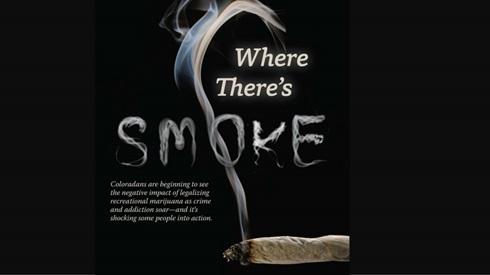This article originally appeared in the August 2015 issue of Citizen magazine. Please feel free to download and share this FREE article with your friends and family ― compliments of Focus on the Family® Citizen magazine.
Resistance to a Colorado law passed in 2012 legalizing the recreational use of marijuana is growing steadily as unnerving results continue to mount.
Some voters who supported the law are now voting to block pot shops in their communities. Education organizations are springing up around the state, and a fledgling repeal movement is underway.
“There is a growing angst among people who are now pushing back,” says Bob Doyle, executive director of the advocacy group Colorado Tobacco Education and Prevention Alliance. “People have become aware of what this is all about—the mass commercialization of marijuana, not social justice or (reducing) incarceration rates.”
A top concern for many people who are now part of the resistance is the fact that kids under the age of 21—the minimum age for purchasing marijuana that was written into the law—are nonetheless consuming it at stunning levels, according to the Rocky Mountain High Intensity Drug Trafficking Area (RMHIDTA), an offshoot of the Office of National Drug Control Policy, which coordinates efforts between federal, state and local drug-enforcement agencies.
Moreover, today’s marijuana includes concentrated products, like cannabis butter or oil, which are made by extracting the psychoactive ingredient of the plant for a very powerful effect.
“I feel like we’re losing a generation. I talk to these kids, mainstream kids, and they are doing the concentrate every day. Every day,” says Diane Carlson, co-founder of Smart Colorado, a youth advocacy group that works with many schools. “The potential for harm and the implications for their future is unfathomable.”
The new law has caused headaches for its neighbors, too. Two states and a consortium of law enforcement agencies from three are suing Colorado for the spillover effects they’re now seeing in their own neighborhoods, where marijuana usage remains illegal.
Far-Ranging Impacts
Carlson admits she was unaware of all the different types of marijuana products that could be sold when the law was being debated in 2012. Now she knows.
They range from traditional joints to candy (lollipops, gummies and cherry drops), desserts (brownies, chocolates and cookies) and even drinks (cappuccinos, fruit punch and sodas). And the levels of its main psychoactive ingredient, tetrahydrocannabinol (THC), are 400 percent higher than they were three decades ago, according to a plethora of sources, including the New England Journal of Medicine.
“We are very concerned at how expansive a law it is and how expansive implementation is, because of the very powerful commercialized marijuana interests,” Carlson tells Citizen.
As a result, marijuana usage is affecting all aspects of life in Colorado—education, business, health care and law enforcement alike.
“You have a lot of negative impacts,” says RMHIDTA Director Tom Gorman. “ER (visits), hospitalization, (citations for driving under the influence of drugs), are all increasing.”
Attorneys general in Oklahoma and Nebraska say that because marijuana remains illegal at the federal level, Colorado’s law has created a “dangerous gap” in federal drug control and is putting financial stress on criminal justice systems. Sheriffs in Kansas and Nebraska, who are also suing Colorado, say the same. For instance, felony drug arrests in Chappell, Neb., seven miles north of the Colorado border, jumped 400 percent over the past three years, city officials told USA Today for a June 2014 story.
Meanwhile, Colorado sheriffs have a suit of their own, saying the law creates a “crisis of conscience” by consistently requiring deputies to choose between state and federal law when dealing with marijuana possession and usage.
Private businesses have another set of concerns. Little Spider Creations, which builds custom props and sets for haunted houses, museums and parks, moved to South Carolina in April after 24 years of being headquartered in Denver. The reason? Too many of the company’s 47 employees were arriving at work high, CEO Mark Brawner told NBC 9 News in Denver.
However, the Colorado Supreme Court issued a landmark ruling in mid-June that could be a game-changer for businessmen like Brawner: The court said a man who was fired in 2010 by Dish Network—which has a zero-tolerance drug policy—could not get his job back, even though he failed the test because he uses marijuana for medical reasons and wasn’t under the influence while on the job. Courts in California, Montana and Washington state have issued similar rulings in the past. The high court’s new ruling could give some teeth back to companies looking for ways to deal with employees who use recreational marijuana in Colorado.
“Marijuana use has been a big challenge for Colorado’s employers,” Carlson says. “The recent Colorado Supreme Court ruling is an important reminder that not only can Colorado’s pot be extremely harmful to our kids’ health, but its use can have extremely negative employment consequences.”
Aiming at the Children
There’s big money in legalized marijuana. Sales hit $700 million in Colorado in 2014—$313 million in the recreational category and $386 million in medical, according to the Colorado Department of Revenue. In the first quarter of 2015, retail cannabis shops sold $118 million worth of marijuana. That number is increasing every quarter, the department says, and recreational sales will likely top $472 million this year.
But for the marijuana industry, Colorado is just a launchpad. The state’s population of 5.3 million people represents only one-sixtieth of the nation’s population, where the real money could be made.
Opponents say the marijuana industry is clearly going after young people, getting them comfortable with the drug and getting them hooked. Edible marijuana products like candies are aimed directly at youth. And with more than 300 retail outlets selling them in Denver alone, they are more prevalent than any other types.
Ben Cort, director of the Colorado Center for Dependency, Addiction and Rehabilitation at the University of Colorado, sees that reality up close.
“It’s not about pot as a leafy plant to smoke, but about edibles clearly designed to appeal to children,” he explains.
Carlson agrees.
“We’re in it. This is the reality for our kids,” she says. “They use fake asthma inhalers and other products, and can take it in class. But they don’t even know what THC means.”
Many of the pot edibles are practically identical to mainstream products—so much so that once out of the wrapper, it’s nearly impossible to tell them apart. But when Carlson’s group and some legislators tried to get a basic marker on candies and foods to let consumers know which ones were laced with pot, they met heavy resistance.
“The pushback from the industry on something as simple as that has been daunting to watch,” she says. Because of the money it’s raking in, the industry is politically influential now, she says, and is interested only in expanding the market.
In fact, in late June, activists began talking about floating a ballot initiative for voters to approve that would allow the public consumption of marijuana in adults-only commercial bars and clubs—a move The Denver Post editorial board described as “questionable” and “overconfident.” To qualify for this November’s ballot, backers must gather 4,700 signatures by Sept. 3.
“There would be no further regulation. Neighbors would have no recourse. And what about when such businesses are near schools, child care facilities or drug treatment centers? Would the city be able to put zoning restrictions or licensing requirements on the adult-use businesses?” the Post pointed out.
Carlson is asking some of the same questions.
“When I talk to my relatives on the East Coast, they have no comprehension of the level of commercialization here,” she says.
Marijuana use by kids between the ages of 12 and 17 is 58 percent higher in Colorado than the national average, according to the RHMIDTA. The rate of use among college-age adults is 54 percent above the national average. Drug-related suspensions from Colorado schools jumped 34 percent from the 2005-2009 period to the 2010-2014 period, while alcohol-related suspensions stayed flat.
Spiking Potency
According to the National Institute of Drug Abuse, THC levels in marijuana averaged about 4 percent 30 years ago, when smoking a joint meant a gentle high. The national average now is 12 percent and rising. But in Colorado, THC levels exceed 20 percent in many of the retail edibles, and can reach 95 percent in the case of concentrates. That exacerbates the drug’s mental and physical impacts, sending addiction levels soaring.
“Potency levels have come to a place no one imagined possible. Even (the marijuana industry trade publication) High Times has been amazed at how potent it is,” says Cort. “There is zero research on how to treat it at this level.”
In 2013, the American Psychiatric Association added cannabis withdrawal to the fifth edition of the Diagnostic and Statistical Manual of Mental Disorders (DSM) as a recognized condition.
“Cannabis takes a lot longer to withdraw from than most any other substance we deal with,” Cort says.
And addiction is spiking: According to the RMHIDTA, the number of people admitted to Denver’s Arapahoe House drug rehabilitation center who listed marijuana as their drug of choice rose from 284 in 2013 to 471 in 2014.
Rising Opposition
“Our kids are getting access to the potent marijuana edibles. Adults are absolutely shocked,” Carlson says.
And that realization is changing attitudes.
Residents of Lakewood, a Denver suburb of 143,000 people, used an option in the law to hold a referendum last November to block any growing, distribution or retail marijuana facilities within the city limits. In 2012, Lakewood voters favored legalizing recreational pot by a 55-45 margin. But last year, they voted 54-46 to block it in their community.
Lakewood resident James Otten, a retired U.S. Geological Survey research scientist, teamed with Colorado Christian University to spearhead the education campaign before the vote.
“We believed that an informed electorate would be generally opposed if they knew the facts,” Otten says. “The overall message after being informed about this marijuana, was that (it) is not safe, and that it is harmful.”
Even suburbs that already have marijuana retailers are fighting to stop new shops from opening. The Wheat Ridge City Council voted 8-0 on Jan. 25 to cap the number of stores at the current number of eight. In fact, 20 municipalities statewide have voted to block marijuana outlets in their jurisdictions, and more are blocking individual stores, says Otten.
A repeal movement is now underway and gaining momentum. An informal group is working to gather a full set of data that can be publicized long before a vote is taken.
“Everything they said would happen has not,” says Gorman. “They said alcohol use would go down. Alcohol use went up. They said it would eliminate the (marijuana) black market. We are the black market. The trends show that legalization is not working.”
FOR MORE INFORMATION
Learn more about the Rocky Mountain High Intensity Drug Trafficking Area at rmhidta.org. To find out more about Smart Colorado, visit smartcolorado.org. To learn more about the Colorado Tobacco Education and Prevention Alliance, log onto ctepa.org. Find out more about the Colorado Center for Dependency, Addiction and Rehabilitation at the University of Colorado by visiting uchealth.org.






